SEO
All You Need to Know to Get Them

Do you want to jump to the first position in Google without building links or significantly updating your content? Featured snippets can help you with that.
Featured snippets are a special type of search result showing a quick answer to the search query at the top of Google’s results page. Google pulls this information from one of the top-ranking pages that then gets elevated to the top of the organic search results this way.
You may be wondering how that’s a good thing for the website that owns the featured snippet. Users see your content on the SERP, and that may mean losing clicks, right?
Well, yes and no. Check this example:

If this question were possible to answer thoroughly in a few sentences, most of us would be out of work. So while the snippet tells you the absolute basics, you still have to click to learn more.
That’s just one example. Featured snippets are one of the most prominent SERP features—and they’re evolving all the time.
Follow this guide to learn everything you need to know about featured snippets and what it takes to optimize for them.
There are five types of featured snippets that Google shows depending on the intent behind the search query:
- Paragraph
- Numbered list
- Bullet list
- Table
- Video
Let’s check an example for each type.
1. Paragraph

This one is a bit special because Google sometimes combines featured snippets with People Also Ask (PAA) boxes. You can see additional questions related to the search query there and click on them to see more information. That often comes from a different source than the featured snippet itself, as you can see in this case:

2. Numbered list

3. Bullet list

4. Table
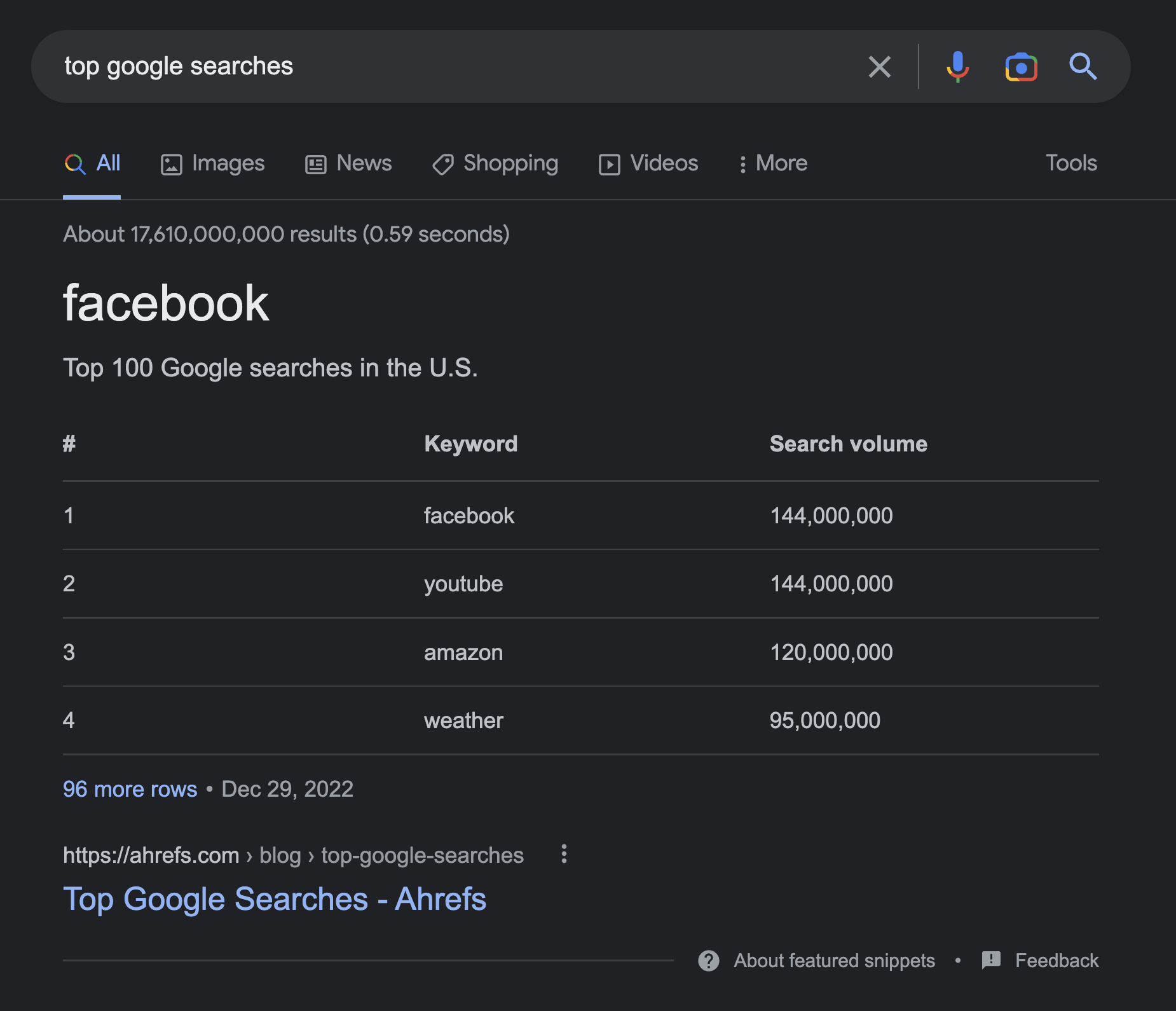
5. Video

It’s also important to note that there are other “snippet-like” results. You need to know about these to avoid any confusion:
Knowledge panel

Knowledge card

Entity carousel

These three SERP features have one thing in common. They don’t pull answers from just one of the top-ranking search results, as they’re based on entities in the knowledge graph. While they may contain a link to the source of information (song lyrics, for example), it’s never in the form of a clickable title as we have in featured snippets.
Google introduced featured snippets in 2014, and I would say that they’re one of the most prominent SERP changes of the past decade. There are quite a few things that featured snippets changed for both users and SEOs.
Shortcut to the top organic position
If your content is ranking on the first SERP for a search query that shows a featured snippet, you can “win” that snippet and shortcut your way to the top position. Let’s break this down.
Our study found that featured snippets come from pages that already rank in the top 10. Moreover, the vast majority of featured snippets pages rank in the top five.
In conclusion, the higher your content ranks, the more likely it is to get a featured snippet.
Getting to the first SERP is a more manageable goal than ranking number #1 for a keyword. But if that keyword triggers a featured snippet, it makes the first position a bit more attainable.
Fewer clicks… sometimes
In the past, the page owning the featured snippet would also be listed in the standard “blue link” search results somewhere on the first SERP. But in January 2020, Google introduced featured snippet deduplication.
Once your page gets elevated to the featured snippet, you lose that “regular” search result.
Besides the little traffic losses back then, some people also think that featured snippets reduce clicks on the search results. After all, if the answer to the query is on the SERP, why would you click on a result?
While this is the case for some queries, it’s certainly not the case for them all. It depends on whether Google can provide a satisfactory answer in the snippet.
For example, take a look at the featured snippet for this query:

The answer is right there for most people. And that’s why there’s only a 19% chance, on average, that the search for this query results in a click.
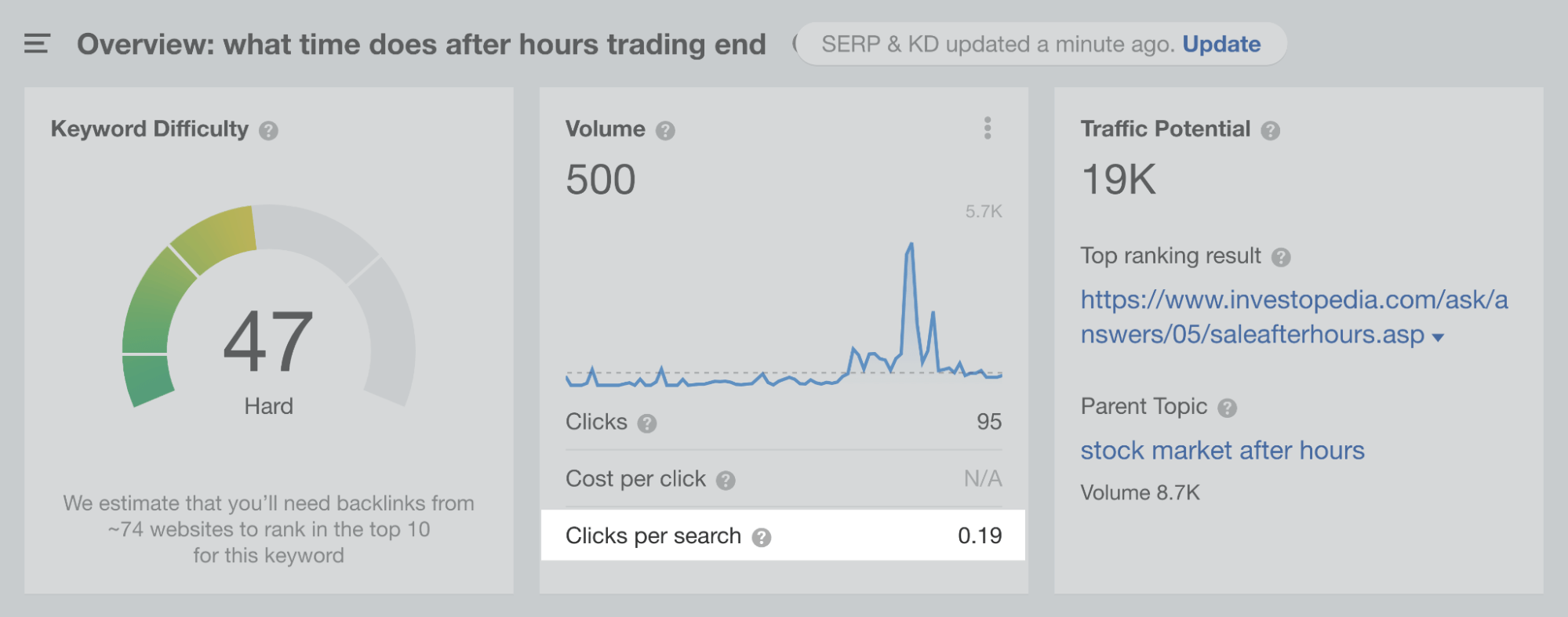
Now take a look at the snippet for “how does the stock market work”:
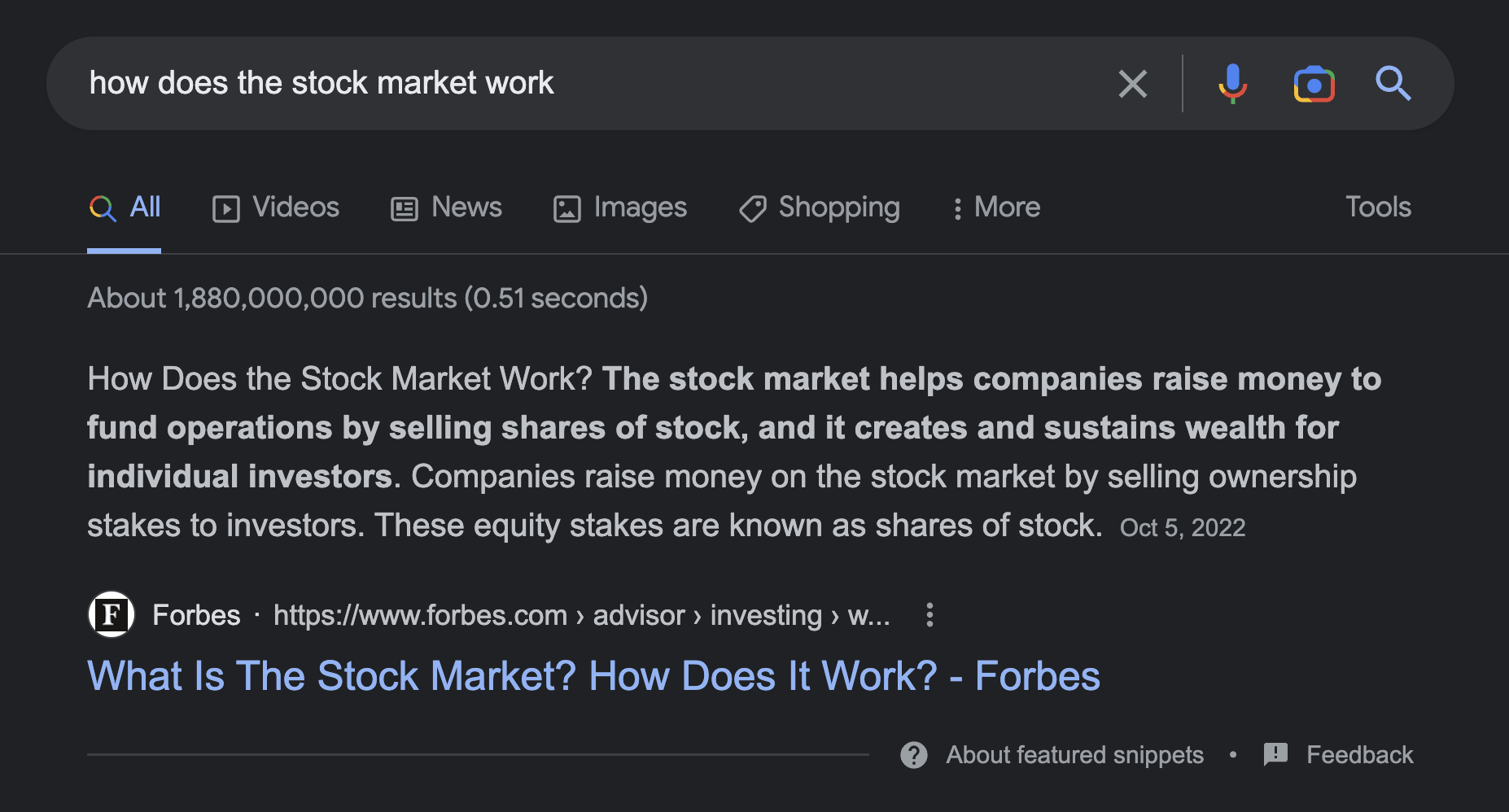
Because it gives a basic answer to the question, most searchers will probably want to know more.
That is most likely why, on average, 82% of searches for this query result in a click.

The takeaway here is that targeting keywords with a low number of Clicks Per Search (CPS) is rarely a good idea.
Pay attention to this when researching keywords in Ahrefs’ Keywords Explorer.

Featured snippets as superb branding opportunities
Clicks aside, featured snippets are the first thing that users see in the search results if there are no search ads. They’re even more prominent on mobile devices where they’re often the only thing people initially see:
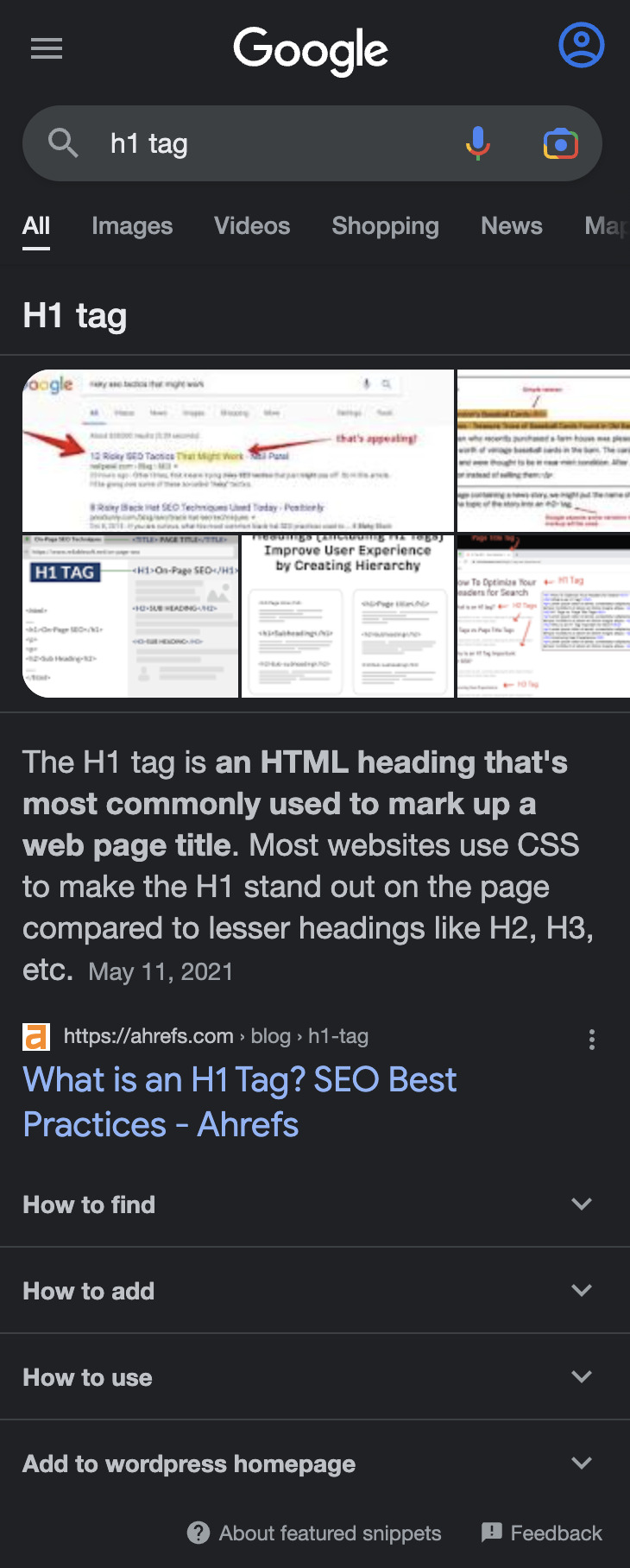
This is a very compelling argument in favor of featured snippets.
Increasing your share of voice on the SERPs is arguably one of the most important SEO KPIs. That’s because brand-building is proven to be the primary driver of long-term growth.
The more your brand is visible on the SERPs for relevant topics, the more you will be associated as a market leader.
You can opt out of featured snippets (don’t do that, though)
Cyrus Shepard led the way in experimenting with opting out of featured snippets after the SERP deduplication and discovered that it led to a 12% traffic loss.
That said, if you still want to opt out of featured snippets, Google offers various ways to do that. Just be aware that both nosnippet robots meta tags methods also block your content from appearing in traditional “blue link” snippets. I don’t recommend using those because Google could then only use your hard-coded title tag and meta description.
So the best way to remove your page from appearing in featured snippets is to include max-snippet robots meta tag. This tag specifies the maximum number of characters Google can show in the text snippets.
And because featured snippets are longer than descriptions in regular snippets, you can set the character limit to the usual maximum length of descriptions. That’s around 160 characters.
You’ll just have to paste this code snippet into the <head> section of the page that you wish to remove from the featured snippets:
<meta name="robots" content="max-snippet:170">
While this method doesn’t guarantee not appearing in shorter featured snippets, it still outweighs the cons of using the more restrictive methods.
Recommendation
For example, here’s a featured snippet that we own:

If we appended “&num=9” to the URL, preferably in Incognito mode, we can see where we’d rank if we weren’t in the snippet:

In this case, if we decided to opt out, we would be in the second or third position—depending on the page that would take over the featured snippet (you’ll see how to do that too).
Being in lower positions and opting out can hurt your traffic. You’ve been warned.
Google Search Console doesn’t show any information regarding featured snippets. You’ll have to use third-party tools like Ahrefs’ Site Explorer to dig into them.
Let’s stick with Site Explorer. Paste in your site, then head to the Organic keywords report to see the keywords you rank for, then filter only for those where Google shows your page in the featured snippet:

As you can see above, Ahrefs’ domain currently ranks for 1,042 keywords with featured snippets in the U.S.
In the previous version of this article, I recommended filtering for keywords with the highest search volume and checking the most important featured snippets manually. That’s because Google sometimes pulls content that isn’t optimal, and you’d want these important featured snippets to be perfect.
However, Google is still improving. Now, I didn’t find a single keyword where I’d bother editing the section Google pulls it from.
While you may come across featured snippets that can do with a bit of polishing, I don’t recommend editing things unless Google pulls poorly formatted, misleading, or just plain wrong information.
It’s better to own an imperfect featured snippet than to risk losing it to a competitor by revising it.
Winning more featured snippets is a simple way to potentially increase organic traffic to your site. Below, we’ll discuss a few ways to do that.
Leverage content that you already have and rank for
Here, we’ll be looking at pages that already rank in the top 10 for a particular term yet don’t own the snippet. It’s possible to win the snippet just by making a few tweaks to your page.
How to find these opportunities? It’s easy.
Go to Site Explorer and filter keywords that trigger featured snippets where your website is ranking in positions #2–10.

This is an easy way to filter out the vast majority if not all the featured snippets that you rank for, since they’re predominantly ranking at the first position. There are cases where they appear at lower positions, but it’s rare these days. In fact, all of our 1,042 featured snippets are ranking at the first position.
In other words, we now have a list of low-hanging opportunities to steal featured snippets from your competitors. Let’s get you prepared for the heist.
We need to prioritize. Stealing 7,064 featured snippets at once is mission impossible.
I reduced the list to just 21 keywords by prioritizing those with higher search volumes where we rank in positions #2–5.
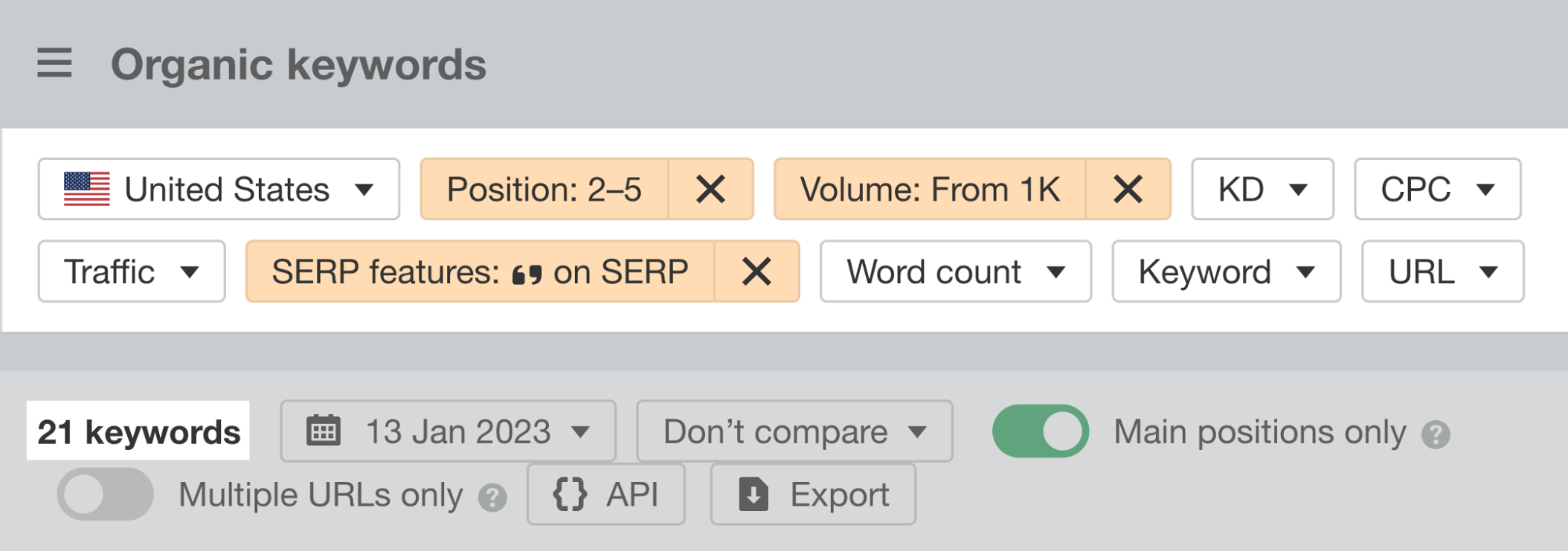
Now things look much more manageable.
The search volume filter is an obvious one, as there’s no point in targeting long-tail keywords at this point. Regarding the positions and referring back to our study, the probability of owning a featured snippet increases with your organic position for that search query.
Again, these filters will be different for you. However, if you don’t rank for a substantial number of keywords already, I’ll suggest focusing on creating more great content and building links.
So we’ve got the list. What’s the battle plan?
In our case, I’ll prioritize further by manually checking for keywords with solid business value. Let’s take a look at some of those keywords:

For example, the search query “most searched thing on google” at the top is less valuable for us than “seo content” at the bottom even though the first has twice the search volume. People who want to learn about creating search-optimized content are much more likely to become our customers one day.
Taking that “seo content” query into account, this is what I see:

First thing I’ll do here is to check whether our page even qualifies for the featured snippet at the moment. That can dictate how big of a change we need to make. You do that by excluding the domain that ranks for the current featured snippet using the - search operator.

In this case, there’s no other page in the featured snippet “queue,” which is an indicator that we currently don’t provide a good, short answer to the search query in the eyes of Google.
Just so you know, here’s an example of a featured snippet that has other eligible pages in line:
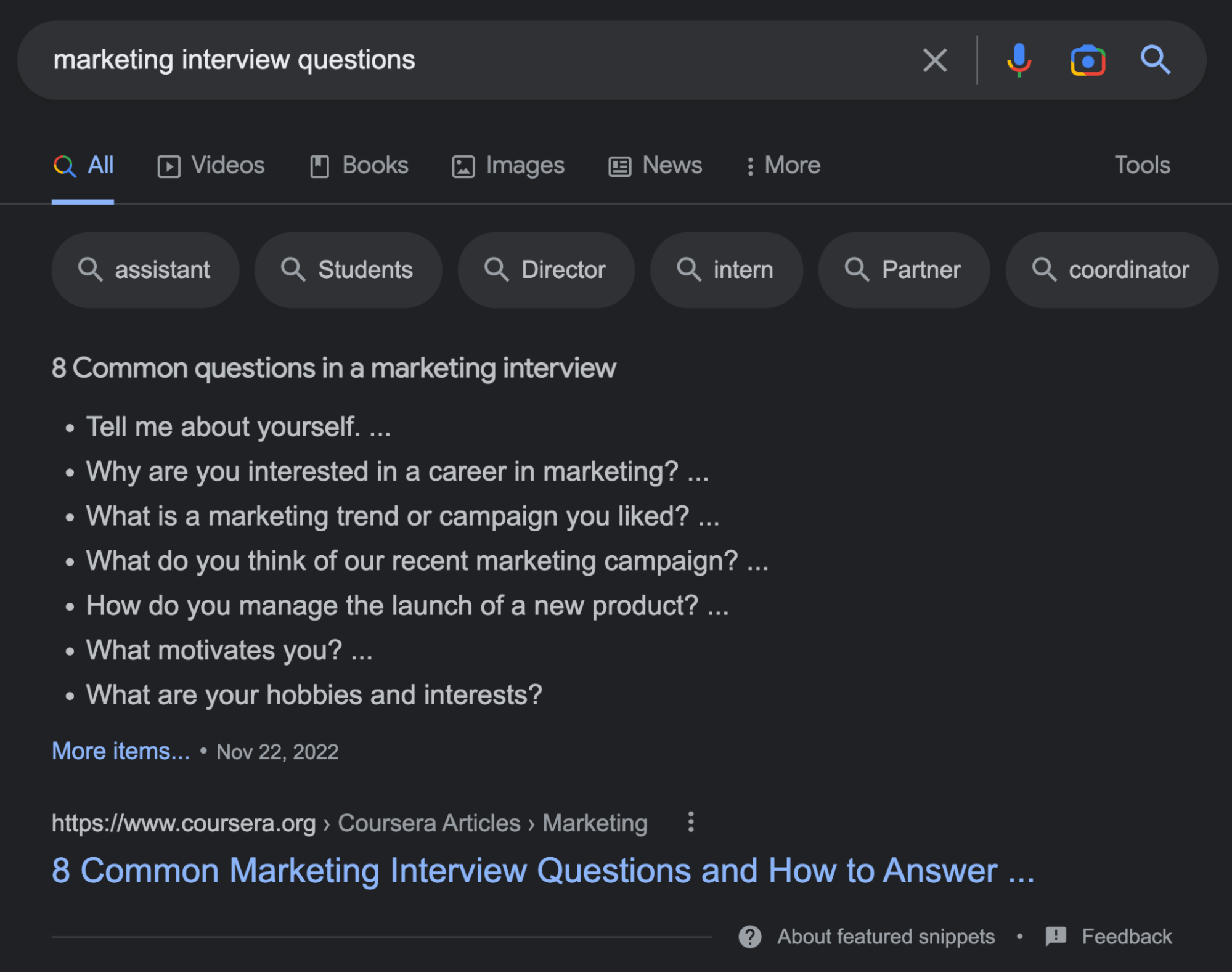
After excluding the Coursera domain, we can see what Google considers as the second-best option:

And you can go on to even see the third domain in line, and so on. But back to optimizing for the “seo content” featured snippet.

We can clearly tell that a short, definition-style paragraph is the way to go here. Let’s check what we have in our content:

So the appropriate section exists; that’s a check. An interesting thing here is that Google ranks a page that targets the keyword in reverse order. Let’s see if other pages qualified for ranking there in the past by opening that keyword in Ahrefs’ Keywords Explorer and scrolling down to the Position history:

I only filtered for URLs that had the featured snippet at one point in the past two years. We can see that the rest targets “seo content” in the original order, and Backlinko claimed the first position for a long time. But we need to check whether Google was even showing the featured snippet back then.
You do that by scrolling further down in Keywords Explorer to the SERP overview. Select a date where you want to investigate the SERP for comparison. In this case, I need any SERP between July and September 2021:
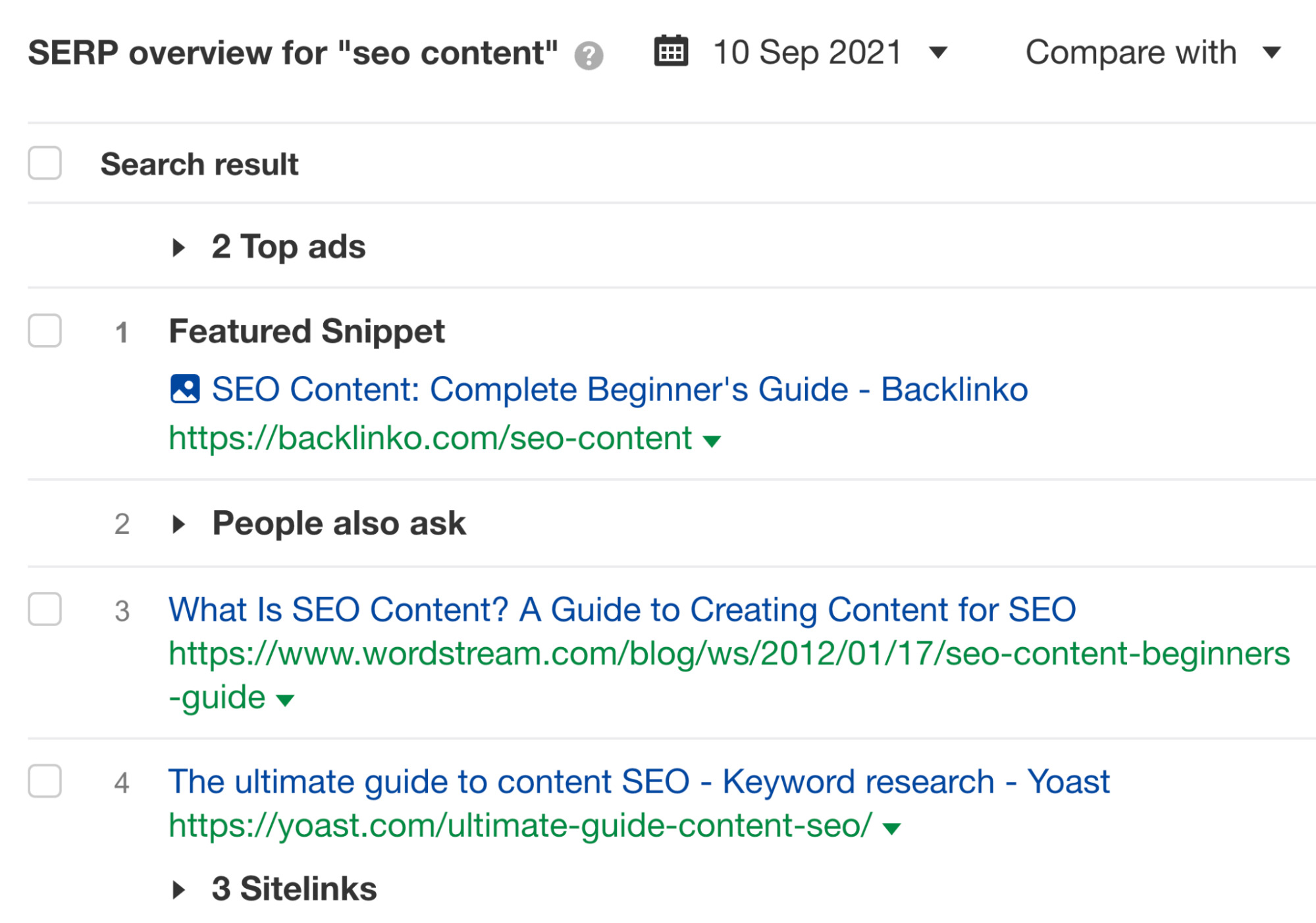
There it is: The featured snippet was there, claimed by another page. The last thing I need here is to check the section that was ranking back then by opening the URL on Archive.org after clicking on the caret:

And selecting a screenshot of that page during the time it was ranking for the featured snippet:

We see three rather different definitions. There’s definitely room for the featured snippet optimization. I’d make our definition a bit longer, change the second sentence, and fit in the mention of keywords because I think that’s important. I’d change it from:
SEO content is content designed to rank in search engines. It could be a blog post, product or landing page, interactive tool, or something else.
To something like this:
SEO content is content designed to rank high in search engines for a specific keyword. Creating it requires researching and covering what searchers would find valuable.
I can honestly say that I feel this definition is superior to the competing ones. That should be your ultimate goal when it comes to optimizing for featured snippets regardless of the format.
This was quite an interesting example. One last thing to note here is that your snippet-worthy information needs to be formatted in a way that Google can easily parse, understand, and interpret. A good rule of thumb is that if the reader comes across that information easily, then Google should be able to as well.
Create new content with featured snippets in mind
Let’s make one thing clear from the start: Scoring a featured snippet should be just the icing on the cake, not the main purpose of why and how you cover a certain topic.
The prerequisite for winning the featured snippet is ranking well, so that should still be the focus. For this reason, I investigate potential featured snippet opportunities only after selecting a topic.
Since the major factor of being successful in SEO is aligning with the search intent, you should always analyze the competing pages on the SERP. Let’s take our main topic here as an example because it doesn’t get better than optimizing content to win featured snippets for “featured snippets” keywords.
I have my “featured snippets” topic, and you should select yours based on your keyword research. Look it up in Ahrefs’ Keywords Explorer and scroll down to the SERP overview:
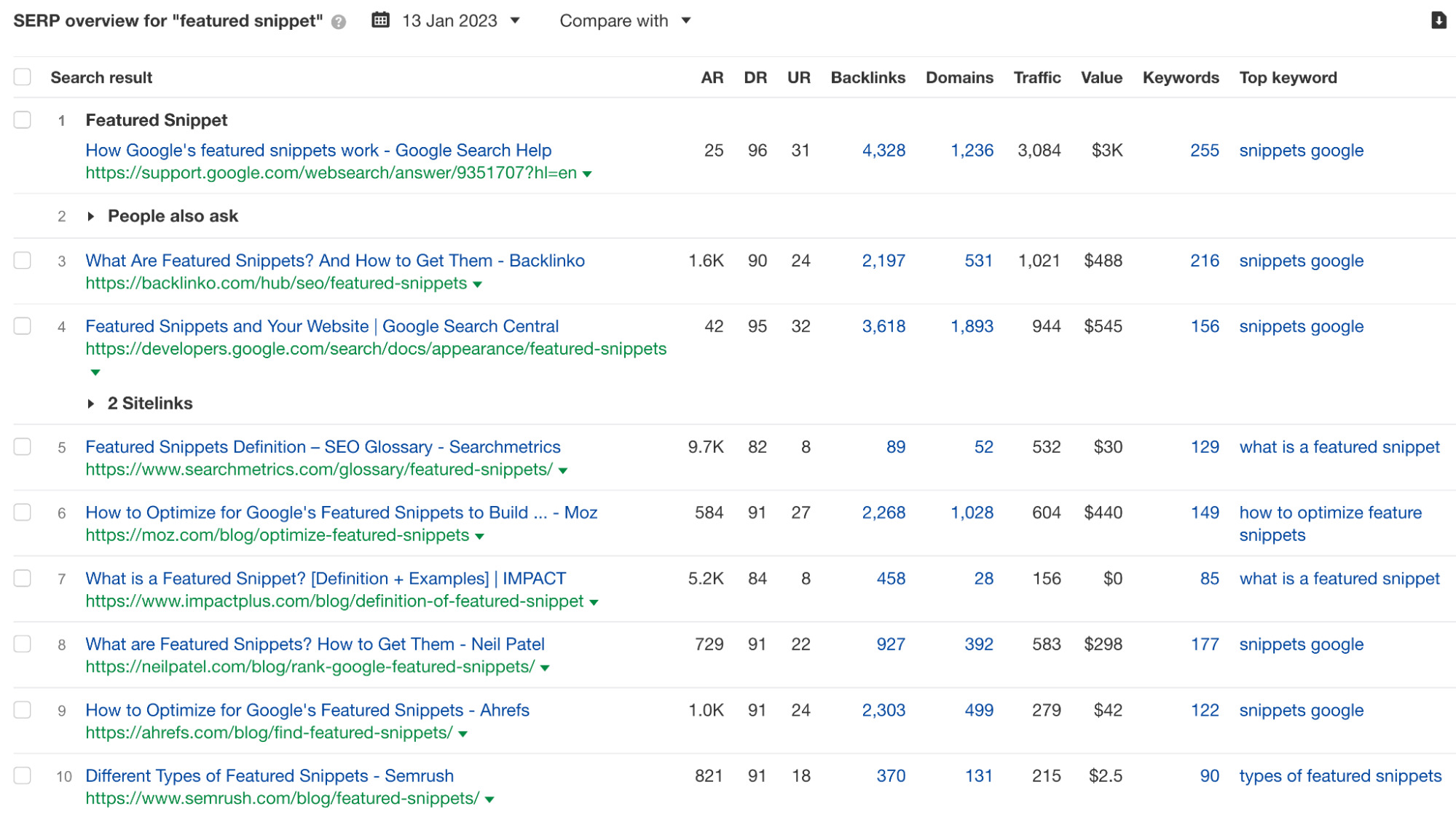
I see that the main keyword triggers a featured snippet, so I’m in the difficult position of trying to dethrone Google there:

Honestly, this is a case of a bad featured snippet. It doesn’t really provide value to the searcher. I don’t learn what it is or how it works. Google has a clear advantage of coining the term, so it’s kind of a branded search. But I’ll try my best to create a definition-type paragraph that I think searchers likely want to see.
We already went through the process of creating content for the “seo content” featured snippet, so this is just a rinse-and-repeat process—provide the best answer possible using a suitable format.
Since pages can rank for thousands of keywords, there are naturally many more featured snippet opportunities than just the one for the main keyword. The easiest way to check these is to click through a few top-ranking pages to see all the keywords they rank for:

And filter the report for keywords that trigger featured snippets and have a certain minimum search volume to make it worthwhile (as we’ve already shown earlier). I also included a “1–20” Position filter to make the list as relevant as possible:

Some of those keywords will be almost the same, having the same search intent and featured snippet. I don’t need to check the featured snippets for keywords like “snippet google” or “what is a featured snippet” because the answer and optimizing your content for them remain the same.
We’re looking for keywords that can trigger different featured snippets and are aligned with sections we cover in the article. There are a bunch of these opportunities around optimizing and getting featured snippets:

Look them up and see what Google shows there:

So if I want to have a chance to rank for this, I should include a straight-to-the-point paragraph on how to get a featured snippet instead of explaining the whole process across many pages. This looks like something that can fit nicely into the “Final thoughts” section to sum it up, so I’ll do that.
And since different pages rank for different keywords, it pays off to repeat this process for one to two more top-ranking pages. I found that I should also optimize for the “types of featured snippets” keyword here.
Even if you don’t end up winning the featured snippets, we’re still trying to answer searchers’ questions in the best way possible. That in itself is critical to your content’s success on the SERPs.
Here are a few copywriting tips for winning featured snippets to wrap this section up. You should:
- Format and structure your content correctly (H1–H6, etc.).
- Try to avoid overcomplicated sentences. Succinct explanations win.
- Use the language of your audience. In the end, Google uses featured snippets as answers in voice search.
- Use the ”inverted pyramid” method (where it makes sense).
pro tip
First, it’s a good idea to do so regardless of featured snippets because it can enhance your plain search result into a rich snippet. But I’ve also seen such pages dominate the combined featured snippets with PAA boxes where everything was from a single source.
Getting a featured snippet is equal to ranking first for a keyword. You may already be tracking keyword ranking positions, so let me help you expand it to tracking featured snippets.
Enter Ahrefs’ Rank Tracker.
First of all, I track all important keywords regardless of their SERP features. But we can begin by adding the most important keywords that also trigger featured snippets.
You can do that in a few clicks through the Organic keywords report we’ve already shown multiple times here. You just have to create a Rank Tracking project first for it to appear here:

You’re all set to see when you win or lose a featured snippet. Go to the Rank Tracker’s Overview report, click on the “SERP features” tab, and check the “Featured snippet” row:

As you can see, from the keywords I’m tracking, the project lost eight featured snippets, while 12 new ones appeared on the SERP over the tracked time period (last 30 days).
Here are the key parts to keep an eye on:
- Number of featured snippets you currently own (plus the +/- change in the selected period)
- Number of featured snippets in total for the keywords you’re tracking (plus the +/- change for the period)
- Percentage of all the featured snippets among the tracked keywords that you own (9%, in this example)
You can also change the view from “all tracked features” to “featured snippets” to see your progress over time:

To delve deeper into the specifics on the keyword level, select the “Featured snippet” filter:
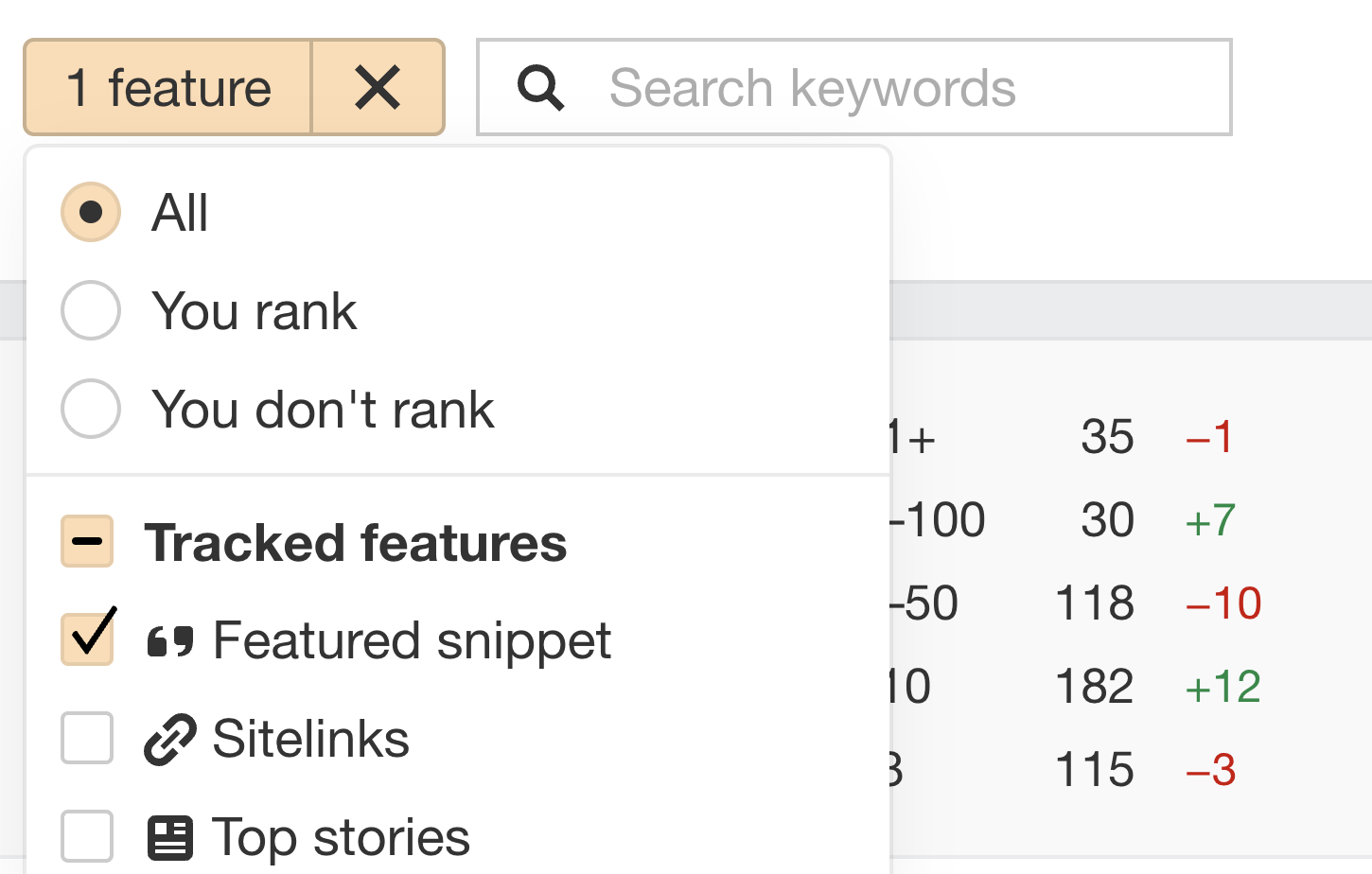
And scroll down to the keywords list to see the time comparison data (30 days, in this example):
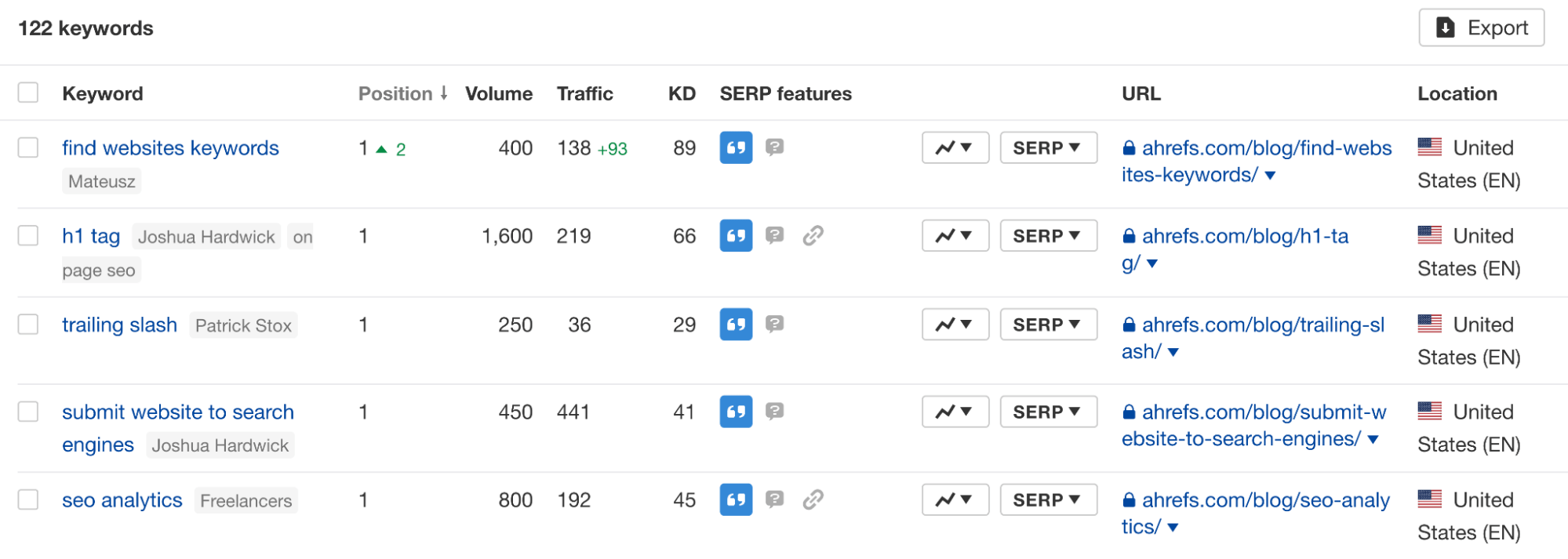
We can see that the top keyword is among our new featured snippets. But it is more helpful to isolate the featured snippet movements only.
To isolate the winning cases, we’ll need to apply two filters:
- Position – Improved (you rank higher than at the start of your selected period).
- SERP features – You rank for the featured snippet.
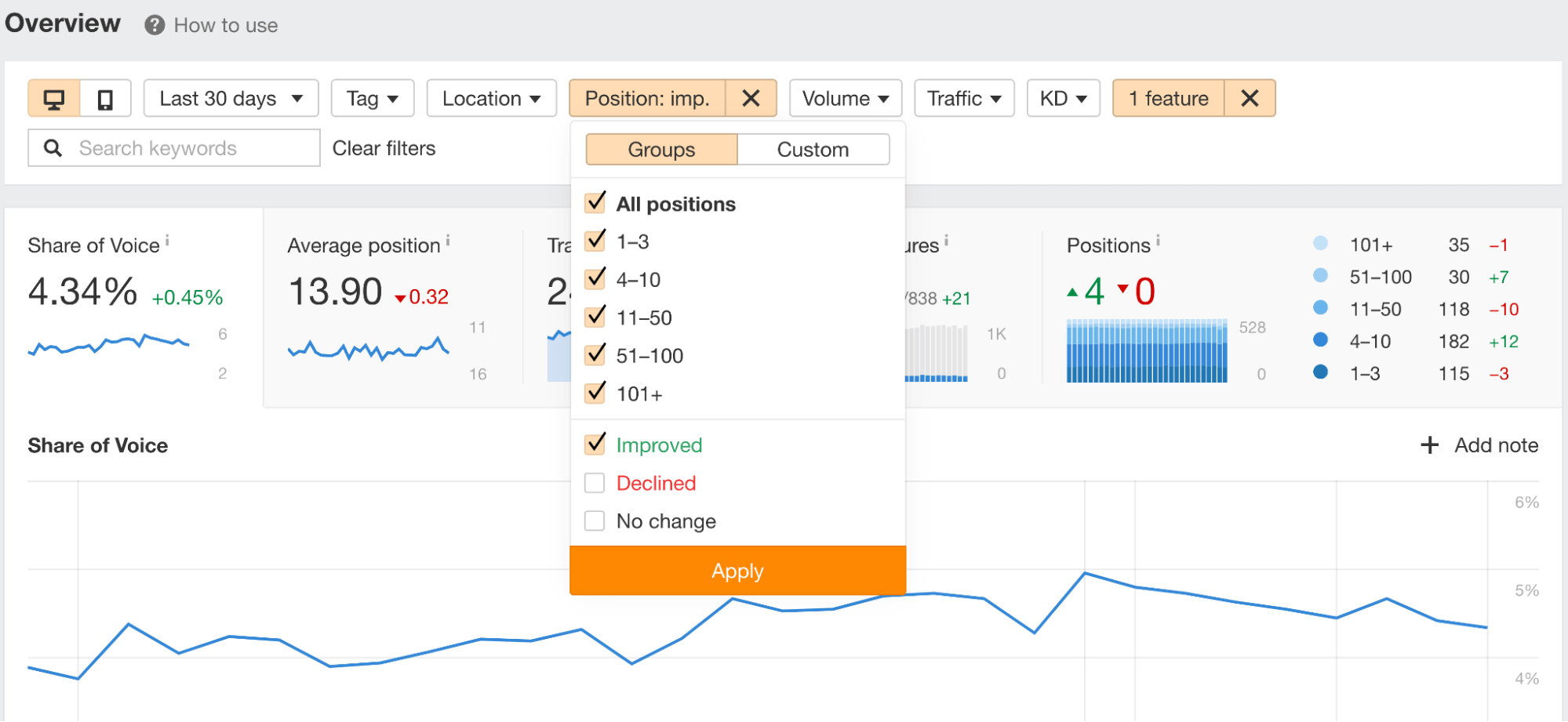
Again, scroll down and see the featured snippet winners of the month (or whatever period you choose):

To see lost featured snippets, just apply reverse filters -> decline in positions in the top 10 and only show featured snippets that you don’t own. Unfortunately, you can’t currently isolate cases where you lost the snippet, so you’ll see all declines in the top 10.
Look for keywords that dropped from the first position, like these first two:
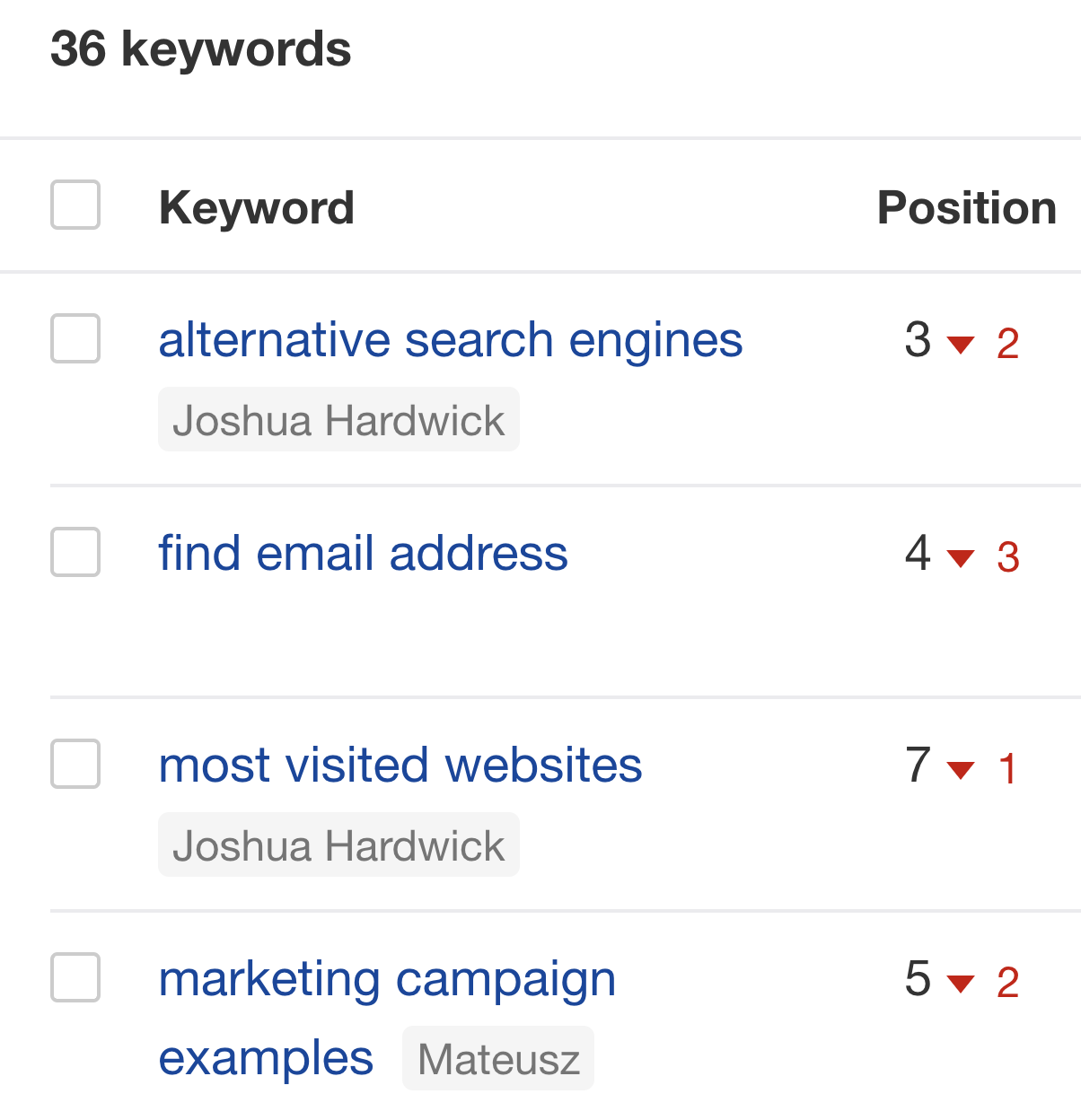
You may want to consider checking the position drops regardless of featured snippets anyway. Sort the table by traffic and pay attention to huge traffic drops.
Final thoughts
You should now know everything necessary to win those coveted SERP jumps to the first position. To sum it up:
Optimizing for featured snippets is about providing a brief and valuable answer to the search query in the most suitable format. Getting the featured snippet involves following all the best SEO practices to make the content rank well for the target keyword.
If you have any comments or questions, don’t hesitate to ping me on Twitter.



















You must be logged in to post a comment Login